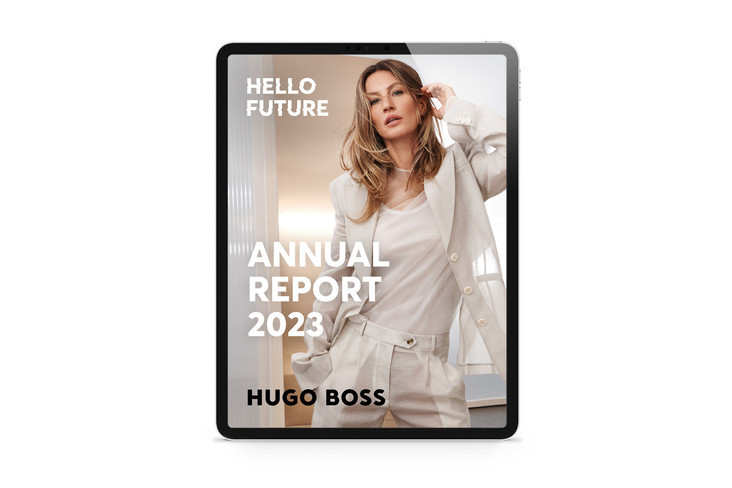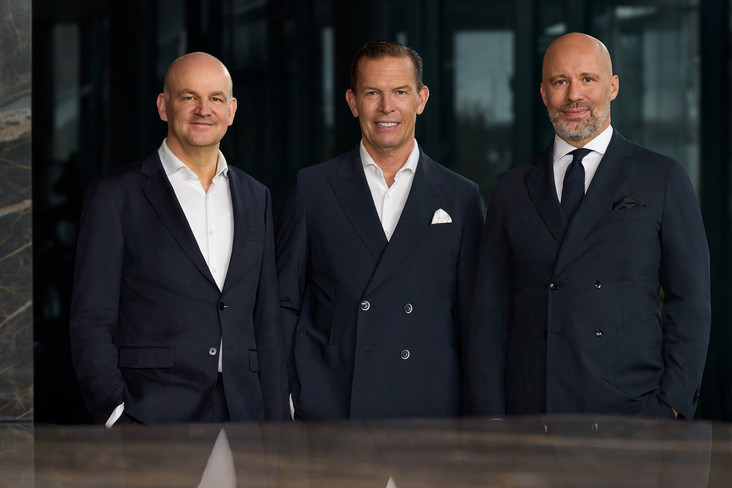Group Management
and Strategy

Key performance indicators
In order to increase its enterprise value, HUGO BOSS focuses on maximizing free cash flow over the long term. By consistently generating positive free cash flow, the Group is confident of safeguarding the liquidity of HUGO BOSS at all times while, at the same time, facilitating the long-term growth of the business.
DEFINITION FREE CASH FLOW
Cash flow from operating activities
+ Cash flow from investing activities
= Free Cash flow
Increasing sales and operating profit (EBIT) is key to improving free cash flow over the long term. In addition, a strict management of trade net working capital and a value-oriented capital expenditure approach support the development of free cash flow. HUGO BOSS has therefore identified four key performance indicators for increasing free cash flow. These comprise sales, EBIT, trade net working capital, and capital expenditure. The 2024 guidance for these key performance indicators is presented here. Details on the financial development of HUGO BOSS in fiscal year 2023 can be found here.
-
Operating Profit (EBIT)
DEFINITION EBIT
Earnings before taxes
– Financial result
= Operating profit (EBIT) -
Trade net working capital
DEFINITION TRADE NET WORKING CAPITAL
Inventories
+ Trade receivables
– Trade payables
= Trade net working capital
Management of inventories as well as trade receivables is the main responsibility of our subsidiaries and the respective operating central departments. The latter are also responsible for managing trade payables. These three balance sheet items are primarily managed by reference to the days of inventories outstanding, days of sales outstanding, and days of payables outstanding. Besides this, there is a specific approval process for the purchase of inventories for our retail business in order to constantly optimize inventory levels. This process takes into account sales quotas as well as expected sales growth and markdown levels.
-
Capital expenditure
Investment activity is primarily focused on our own retail network, the digitalization of our business model, as well as the expansion of our global logistic capacities. As part of our strategic claim “Drive Omnichannel,“ we are pushing ahead with the further optimization and modernization of our global store network, with the vast majority of our own stores being refreshed by the end of 2025. In line with our claim “Lead in Digital,” digital investments are pushed along the entire value chain – from digital trend detection and product creation to digital showrooms, the continuous enhancement of our own online business, to our general IT infrastructure. Going forward, as part of our claim “Organize for Growth,” HUGO BOSS also aims to step up investments into its global logistic capacities. This also includes the strategic expansion of one of our key logistic hubs near our headquarters in Metzingen initiated in late 2023. A specific approval process exists for material investment projects. Apart from qualitative analyses, e.g., with respect to potential store locations, this also includes an analysis of each project’s net present value.
Group Strategy
Our “CLAIM 5” growth strategy is closely linked to our vision and ambition of being the leading premium tech-driven fashion platform worldwide and becoming one of the top 100 global brands. Our strategy is thereby based on five strategic pillars: “Boost Brands,” “Product is Key,” “Lead in Digital,” “Drive Omnichannel,” and “Organize for Growth.” It also includes a bold commitment to sustainability, together with a strong executional road map, and a firm commitment to empower people and teams.
“CLAIM 5” aims to strongly accelerate the relevance of BOSS and HUGO and drive superior top-line growth. In doing so, the Company is committed to continuing its market-share-winning trajectory also in the years to come. At the same time, our strategy is intended to further ensure a sustainable increase in profitability as well as strong free cash flow generation. All initiatives aimed at driving sales growth are therefore also measured by their potential to sustainably grow operating profit (EBIT). In this context, and as part of “CLAIM 5,” we aim to realize further efficiency gains, in particular in brick-and-mortar retail, to compensate for further investments into our business.


